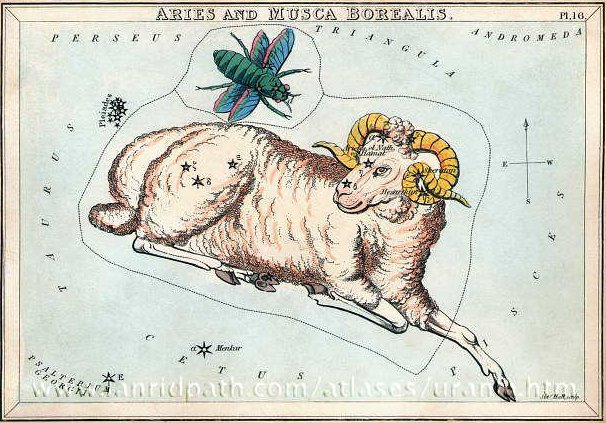|
4. I think there was a misunderstanding, because the 'Barbarians' probably said the 7 small stars were flies (muscidae): ... Bayer said that 'the Barbarians' called this [ο] Muscida, a word apparently coined in the Middle Ages for the muzzle of an animal, the feature of the Bear, that the star marks ... We remember the great northern fly descending towards Aries in the 3rd hour:
Musca Borealis could represent the spirit of Sun returning with light in spring. The 7 smaller flies could represent the 7 planets in the nighttime. Ga3-7 can be compared with Gb8-7 (13 glyph lines later):
13 * 29½ = 383½ and from Ga3-7 to Gb8-7 there are 449 - 67 = 382 glyphs. Museida at 130.9 + 408 = 538.9 is rising a quarter after the Head of the Fly. Puo ('hilled up') in Gb8-8 is probably the opposite of manu rere (the 'beast' flying high) in Ga3-8.
... Bharani ... is the second nakshatra in Hindu astronomy, corresponding to 35, 39, and 41 Arietis. In Jyotisha, Bharani is ruled by Shukra (the planet Venus). Also, it is classified as a Cruel or Active nakshatra, meaning that, under electional astrological beliefs, works of a harmful or deceptive nature are best conducted while the moon is Bharani. Bharani is seen as being under the domain of Yama, the god of death or Kālī. The symbol of Bharani is the Yoni, a representation of the female sexual organ ... When the head of king Hotu Matua had been buried for a while the flies were swarming: and then they went up into the sky: ... When all had left, when all the brothers were asleep, Tuu Maheke came and cut off the head of Hotu A Matua. Then he covered everything with soil. He hid (the head), took it, and went up. When he was inland, he put (the head) down at Te Avaava Maea. Another day dawned, and the men saw a dense swarm of flies pour forth and spread out like a whirlwind (ure tiatia moana) until it disappeared into the sky. Tuu Maheke understood. He went up and took the head, which was already stinking in the hole in which it had been hidden. He took it and washed it with fresh water. When it was clean, he took it and hid it anew. Another day came, and again Tuu Maheke came and saw that it was completely dried out (pakapaka). He took it, went away, and washed it with fresh water until (the head) was completely clean. Then he took it and painted it yellow (he pua hai pua renga) and wound a strip of barkcloth (nua) around it. He took it and hid it in the hole of a stone that was exactly the size of the head. He put it there, closed up the stone (from the outside), and left it there. There it stayed ... The position of Museida is 130 + 1 days after equinox, i.e. about 40 days after the solstice. The Head of the Fly (presumably the opposite of the head of the Sun King) is 448.6 - 408 = ca 40 days after equinox. South of the equator the single Great Fly descends 40 days after autumn equinox. And a quarter later, 40 days after winter solstice, a multitude of flies could be returning up again into the sky like a whirlwind. Next we can expect a season when the skull is completely dried out and clean, maybe refering to Cancer.
Neither hair nor feathers are growing on the shell, it is completely clean. |





